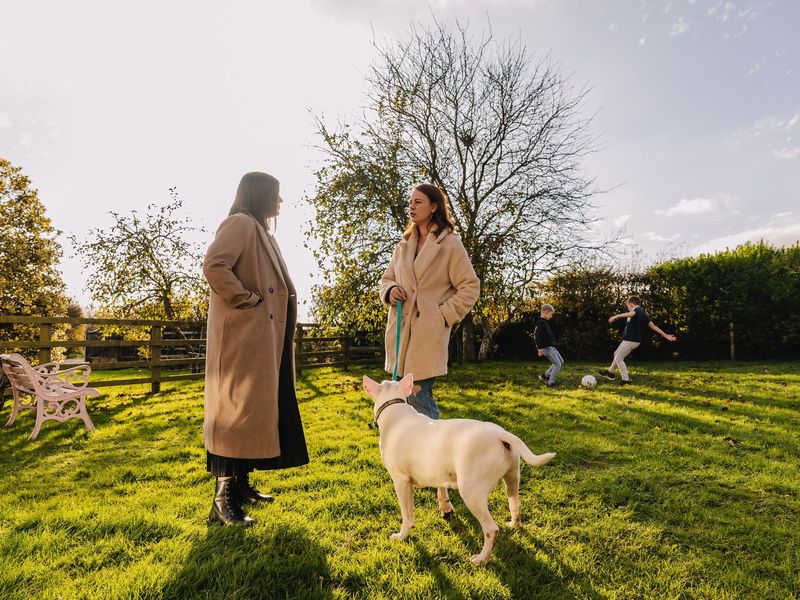Situation stacking
Situation stacking occurs when a dog has too many experiences in quick succession and becomes overwhelmed.

Situation-stacking is also referred to as trigger-stacking or stressor-stacking. This is where often short-lived and separate situations that a dog experiences –good or bad – happen one after the other, without time for the dog to calm down in between.
This means that all the associated feelings of excitement or anxiety stack up, building the dog’s level of arousal or alertness until suddenly they become overwhelmed and completely unable to relax.
For example, a dog who has been walked to the veterinary clinic along a busy high street and had several people approach and interact, without any choice to avoid this contact, might have become increasingly excited or scared by each interaction, depending on how they feel about new people. Imagine how that dog might then feel about the next person to approach them. It will be very difficult for them to remain calm or able to relax, and for some dogs, this results in them becoming completely overwhelmed.
Reaching the tipping point
The point at which a dog might switch from tolerating any given situation to being completely unable to cope could be thought of as a tipping point, often referred to as a ‘threshold’.
Because behaviour is dependent on so many factors unique to each individual, this threshold will be different for every dog – or person, as we can be affected by this phenomenon too. As a dog moves closer and closer to their personal tipping point, perhaps because they are becoming increasingly excited or fearful, they are likely to respond with greater sensitivity than usual to what is happening around them.
This is because dogs’ bodies respond physiologically to things they experience emotionally (as discussed in acute and chronic stress response). This in turn affects their behaviour, particularly when there is little time for a homeostatic return between each arousing situation.
Situation stacking in the veterinary clinic
Potential situations in the veterinary clinic that a dog might be aroused by, and therefore have the potential to create a negative accumulative effect, include:
- the journey to the clinic – for example, by public transport
- owner behaviour – for example, if the owner is agitated and restless
- the waiting room experience – including the sights, sounds and smells of people and other animals who are unwell and/or frightened or excited
- being lifted onto a consultation table, restrained, and handled
- the behaviour of, and interaction with, the clinician – for example, if agitated, tense and/or forceful.
Avoiding situation stacking within the veterinary clinic
The more aware we are of the concept of situation stacking, the more we can do to prevent potential triggers stack up for the dogs in our care. Veterinary clinics can contribute in the two ways explained below.
Help owners understand situation-stacking
So they can be aware of any triggers which might affect their dog in the time prior to their appointment, and avoid them as much as possible.
An owner might not be able to remove the trigger of pain for their dog, but they might be able to reduce the likelihood of other potential triggers which could heighten their dog’s arousal levels, such as:
- driving to the appointment instead of taking public transport
- waiting in the car instead of bringing their dog into a busy waiting room.
Find out more about how to travel on public transport or in a car with your dog.
Avoid introducing any unnecessary potential triggers
Where possible, limit a dog’s exposure to sights, sounds and smells which could further increase their arousal or sensitivity.
This could be done by implementing some or all of the following measures:
- barriers between patients in the waiting room to avoid unsolicited eye contact or interaction
- reducing background sounds by asking colleagues to avoid using clippers momentarily or reducing the telephone ringer volume
- only interacting physically with a dog when absolutely necessary
- politely discouraging other people present in the waiting room from interacting with anyone else’s pet and encouraging dog owners to sit apart from any other people/animals present
- signpost quieter times to book appointments for dogs who find the veterinary environment particularly challenging – although these can never be guaranteed.
Join the Dog Friendly Clinic scheme
Start your journey today by visiting Dog Friendly Clinic Campus and signing up with the key: 4dLsphL2nh2x
Remember to keep note of your username, as you’ll need it each time you log in. If you’re registering on behalf of a clinic, be sure to choose a name that is clear and appropriate for your clinic.
If you don't want to join the scheme but would like to access some of our web pages, visit our Dog Friendly Clinic resources for some of our webpages containing the course content.
Need help?
If you have any questions regarding the scheme or your application, please contact our helpful Dog Friendly Clinic Team.
Disclaimer notice: The advice given on this website [in these materials] is intended for your general information only and should not be relied upon as specific advice for any veterinary practice or clinic. Each veterinary practice or clinic will be unique in its physical environment and each dog attending the veterinary practice or clinic will have specific needs and requirements, which the veterinary practice or clinic is solely responsible for. Unless prohibited by law, Dogs Trust and the British Veterinary Behaviour Association do not accept liability to any person veterinary practice or clinic relating to the use of this information.



